
Home - Search - Browse - Alphabetic Index: 0- 1- 2- 3- 4- 5- 6- 7- 8- 9
A- B- C- D- E- F- G- H- I- J- K- L- M- N- O- P- Q- R- S- T- U- V- W- X- Y- Z
Skylab 2
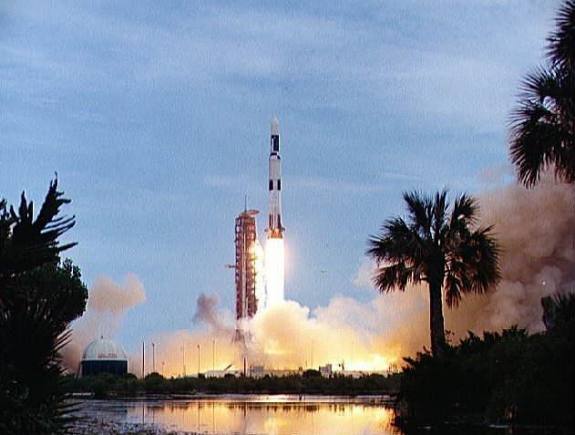
Saturn V Skylab
Credit: NASA
AKA: Skylab. Launched: 1973-05-25. Returned: 1973-06-22. Number crew: 3 . Duration: 28.03 days. Location: Naval Aviation Museum, Pensacola, FL.
Epic repair mission which brought Skylab into working order. Included such great moments as Conrad being flung through space by the whiplash after heaving on the solar wing just as the debris constraining it gave way; deployment of a lightweight solar shield, developed in Houston in one week, which brought the temperatures down to tolerable levels. With this flight US again took manned spaceflight duration record.
Skylab 2 , consisting of a modified Apollo CSM payload and a Saturn IB launch vehicle, was inserted into Earth orbit approximately 10 minutes after liftoff. The orbit achieved was 357 by 156 km and, during a six-hour period following insertion, four maneuvers placed the CSM into a 424 by 415 km orbit for rendezvous with the Orbital Workshop. Normal rendezvous sequencing led to stationkeeping during the fifth revolution followed by a flyaround inspection of the damage to the OWS. The crew provided a verbal description of the damage in conjunction with 15 minutes of television coverage. The solar array system wing (beam) 2 was completely missing. The solar array system wing (beam) 1 was slightly deployed and was restrained by a fragment of the meteoroid shield. Large sections of the meteoroid shield were missing. Following the flyaround inspection, the CSM soft-docked with the OWS at 5:56 p.m. EDT to plan the next activities. At 6:45 p.m. EDT the CSM undocked and extravehicular activity was initiated to deploy the beam 1 solar array. The attempt failed. Frustration of the crew was compounded when eight attempts were required to achieve hard docking with the OWS. The hard dock was made at 11:50 p.m. EDT, terminating a Skylab 2 first-day crew work period of 22 hours.
The Skylab space station was launched May 14, 1973, from the NASA Kennedy Space Center by a huge Saturn V launch vehicle, the moon rocket of the Apollo Space Program. Sixty-three seconds after liftoff, the meteoroid shield--designed also to shade Skylab's workshop--deployed inadvertently. It was torn from the space station by atmospheric drag. This event and its effects started a ten-day period in which Skylab was beset with problems that had to be conquered before the space station would be safe and habitable for the three manned periods of its planned eight-month mission.
When the meteoroid shield ripped loose, it disturbed the mounting of workshop solar array "wing" two and caused it to partially deploy. The exhaust plume of the second stage retro-rockets impacted the partially deployed solar array and literally blew it into space. Also, a strap of debris from the meteoroid shield overlapped solar array "wing" number one such that when the programmed deployment signal occurred, wing number one was held in a slightly opened position where it was able to generate virtually no power.
In the meantime, the space station had achieved a near-circular orbit at the desired altitude of 435 kilometers (270 miles). All other major functions including payload shroud jettison, deployment of the Apollo Telescope Mount (Skylab's solar observatory) and its solar arrays, and pressurization of the space station occurred as planned.
Scientists, engineers, astronauts, and management personnel at the NASA Marshall Space Flight Center and elsewhere worked throughout the first ten-day period of Skylab's flight to devise the means for its rescue. Simultaneously, Skylab--seriously overheating--was maneuvered through varying nose-up attitudes that would best maintain an acceptable "holding" condition. Because of the loss of the meteoroid shield, however, this positioning caused workshop temperatures to rise to 52 degrees Celsius (126 degrees F). During that ten-day period and for some time thereafter, the space station operated on less than half of its designed electrical system, in the partially nose-up attitudes, was generating power at reduced efficiency. The optimum condition that maintained the most favorable balance between Skylab temperatures and its power generation capability occurred at approximately 50 degrees nose-up.
The crew rendezvoused with Skylab on the fifth orbit. After making substantial repairs, including deployment of a parasol sunshade which cooled the inside temperatures to 23.8 degrees C (75 degrees F), by June 4 the workshop was in full operation. In orbit the crew conducted solar astronomy and Earth resources experiments, medical studies, and five student experiments; 404 orbits and 392 experiment hours were completed; three EVAs totaled six hours, 20 minutes.
Skylab-2 MANHOUR UTILIZATION
MEDICAL ACTIVITIES 145.3 HOURS 7.5 PERCENT
SOLAR OBSERVATIONS 117.2 " 6.0 "
EARTH RESOURCES 71.4 " 3.7 "
OTHER EXPERIMENTS 65.4 " 3.4 "
SLEEP, REST & OFF
DUTY 675.6 " 34.7 "
PRE/POST SLEEP &
EATING 477.1 " 24.5 "
HOUSEKEEPING 103.6 " 5.3 "
PHYSICAL TRAINING
& PERSONAL HYGIENE 56.2 " 2.9 "
OTHER (EVA) ETC 232.5 " 12.0 "
TOTAL: 1944.3 " 100 "
More at: Skylab 2.
Family: Manned spaceflight. People: Conrad, Kerwin, Weitz. Country: USA. Spacecraft: Apollo CSM. Launch Sites: Cape Canaveral. Agency: NASA Houston.
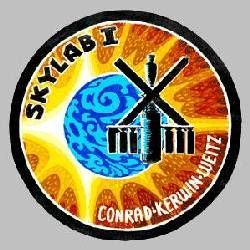 | Skylab 2 Credit: www.spacefacts.de |
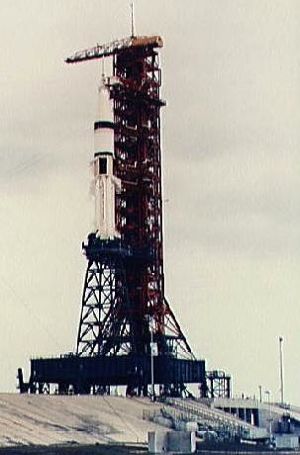 | Skylab 2 View of Pad B, Launch Complex 39 showing Skylab 2 space vehicle during CDDT Credit: NASA |
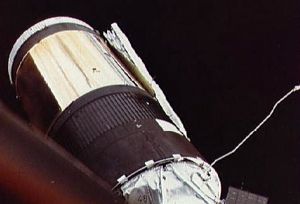 | Skylab 2 Rendezvous and Fly Around Inspection of Skylab I Orbital Space Station Credit: NASA |
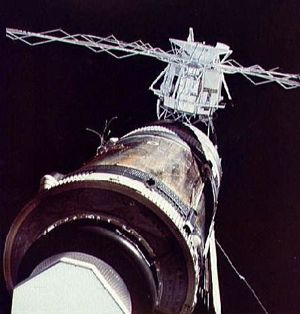 | Skylab 2 Rendezvous and Fly Around Inspection of Skylab I Orbital Space Station Credit: NASA |
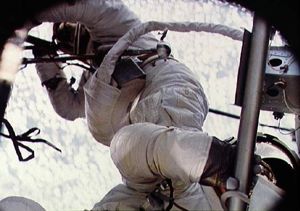 | Skylab 2 View of crewmen performing EVA taken from inside OWS Credit: NASA |
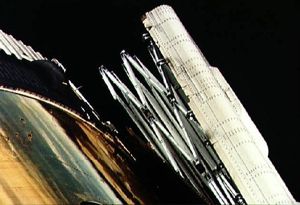 | Skylab 2 Close-up view of partially deployed, damaged solar array Credit: NASA |
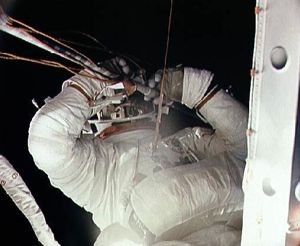 | Skylab 2 Skylab 2 Crewmember During EVA to Repair and Deploy Damaged Solar Panel Credit: NASA |
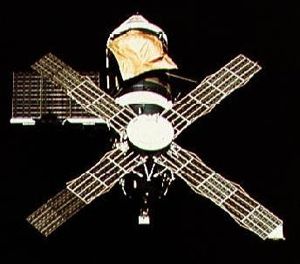 | Skylab 2 Skylab 2 Farewell View from the Departing Skylab Command/Service Module Credit: NASA |
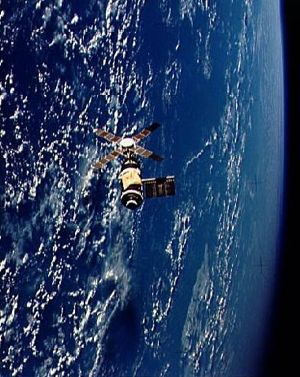 | Skylab 2 Skylab 2 Farewell View from the Departing Skylab Command/Service Module Credit: NASA |
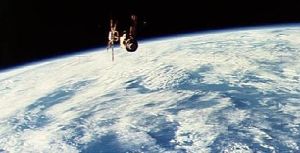 | Skylab 2 Skylab 2 Farewell View from the Departing Skylab Command/Service Module Credit: NASA |
1972 July 18-19 - .
- The first command and service modules designed for the Skylab Program were delivered by North American Rockwell. - .
Nation: USA.
Program: Skylab.
Flight: Skylab 2.
The first command and service modules designed for the Skylab Program were delivered by North American Rockwell. The CSM arrived at KSC via the Super Guppy aircraft. Upon arrival, the CSM, which would be launched on SL-2, was installed in the Operations and Checkout Building to begin its checkout procedure.
1972 August 18 - .
- The Saturn IB first stage for Skylab 2 arrived at KSC. - .
Nation: USA.
Program: Skylab.
Flight: Skylab 2.
The Saturn IB first stage for the Skylab 2 launch arrived at KSC aboard the NASA barge Orion and was immediately offloaded for processing in the Vehicle Assembly Building (VAB). Following preliminary checkout in the VAB transfer aisle, the S-IB 206 first stage would be erected atop the 39- m-tall pedestal on Mobile Launcher 1 on 31 August.
1972 November 24 - .
- Skylab debris situation reviewed. - . Nation: USA. Program: Skylab. Flight: Skylab 2. The Skylab debris situation was reviewed with emphasis on the S-IVB stages of Skylab 2, 3, and 4. It was decided that the S-IVB for these missions would be deorbited into the Pacific Ocean on an early revolution.. Additional Details: here....
1973 February 27 - May 25 - . LV Family: Saturn I. Launch Vehicle: Saturn IB.
- Skylab 2 spacecraft transferred to Launch Complex 39B in preparation for launch. - .
Nation: USA.
Program: Skylab.
Flight: Skylab 2.
The Skylab 2 spacecraft, mated to its launch vehicle, was transferred 27 February from the KSC Vehicle Assembly- Building to Launch Complex 39B in preparation for launch. The SL-2 space vehicle consisted of the following major components: an S-IB (the first stage); an S-IVB (the second stage, which comprised the propulsion stages); an IU; a CSM; and an SLA. Additional Details: here....
1973 March 25-30 - .
- The Skylab flight hardware successfully completed the first total mission operations sequence - .
Nation: USA.
Program: Skylab.
Flight: Skylab 2.
The Skylab flight hardware successfully completed the first total mission operations sequence during the mission simulation and flight readiness test at KSC. The test included the SL 2 astronaut crew participation in the simulated launches of SL-1 and SL-2, mission activation and operation, deactivation, data dump, and powerdown.
1973 March 28 - .
- USNS Vanguard to provide communication between Skylab and Mission Control Center - .
Nation: USA.
Program: Skylab.
Flight: Skylab 2.
The USNS Vanguard, a part of NASA's Space Flight Tracking and Data Network, departed Port Canaveral, Florida, for temporary duty at Mar del Plata, Argentina. The ship would provide a two- way flow of information and communication between Skylab and Mission Control Center in Houston via Goddard Space Flight Center. Upon completion of the Skylab Program, it would return to Port Canaveral. The Vanguard was originally designed to provide tracking and data acquisition for the Apollo flights. It played an important role in the Apollo Program.
1973 April 16-19 - .
- Loading of the Apollo spacecraft's hypergolic propellants for a scheduled 15 May launch was completed at KSC. - .
Nation: USA.
Program: Skylab.
Flight: Skylab 2.
Loading of the Apollo spacecraft's hypergolic propellants for a scheduled 15 May launch was completed at KSC. The next major milestone in preparing the Saturn IB/Apollo for launch would occur 23 April when the kerosene to fuel the Saturn IB booster's eight engines would be pumped aboard the first stage.
1973 May 23-24 - .
- A design certification review was held for the revised Skylab 2 mission. - .
Nation: USA.
Program: Skylab.
Flight: Skylab 2.
Spacecraft: Skylab.
The review board determined that a 'Skylab parasol,' with a strengthened ultraviolet resistant material, deployed through the scientific airlock would be the prime method for the deployment of a thermal shield on the Orbital Workshop. A 'twin pole' thermal shield and a standup extravehicular thermal sail would be flown as backup methods. Following final assessment of mission readiness with favorable recommendations, a certification of flight worthiness for the new hardware was executed.
1973 May 25 - . 13:00 GMT - . Launch Site: Cape Canaveral. Launch Complex: Cape Canaveral LC39B. Launch Platform: LUT1. LV Family: Saturn I. Launch Vehicle: Saturn IB.
- Skylab 2 - .
Call Sign: Skylab. Crew: Conrad,
Kerwin,
Weitz.
Backup Crew: McCandless,
Musgrave,
Schweickart.
Payload: Apollo CSM 116. Mass: 19,979 kg (44,046 lb). Nation: USA.
Agency: NASA Houston.
Program: Skylab.
Class: Moon.
Type: Manned lunar spacecraft. Flight: Skylab 2.
Spacecraft: Apollo CSM.
Duration: 28.03 days. Decay Date: 1973-06-22 . USAF Sat Cat: 6655 . COSPAR: 1973-032A. Apogee: 440 km (270 mi). Perigee: 425 km (264 mi). Inclination: 50.00 deg. Period: 93.20 min.
Epic repair mission which brought Skylab into working order. Included such great moments as Conrad being flung through space by the whiplash after heaving on the solar wing just as the debris constraining it gave way; deployment of a lightweight solar shield, developed in Houston in one week, which brought the temperatures down to tolerable levels. With this flight US again took manned spaceflight duration record.
Skylab 2 , consisting of a modified Apollo CSM payload and a Saturn IB launch vehicle, was inserted into Earth orbit approximately 10 minutes after liftoff. The orbit achieved was 357 by 156 km and, during a six-hour period following insertion, four maneuvers placed the CSM into a 424 by 415 km orbit for rendezvous with the Orbital Workshop. Normal rendezvous sequencing led to stationkeeping during the fifth revolution followed by a flyaround inspection of the damage to the OWS. The crew provided a verbal description of the damage in conjunction with 15 minutes of television coverage. The solar array system wing (beam) 2 was completely missing. The solar array system wing (beam) 1 was slightly deployed and was restrained by a fragment of the meteoroid shield. Large sections of the meteoroid shield were missing. Following the flyaround inspection, the CSM soft-docked with the OWS at 5:56 p.m. EDT to plan the next activities. At 6:45 p.m. EDT the CSM undocked and extravehicular activity was initiated to deploy the beam 1 solar array. The attempt failed. Frustration of the crew was compounded when eight attempts were required to achieve hard docking with the OWS. The hard dock was made at 11:50 p.m. EDT, terminating a Skylab 2 first-day crew work period of 22 hours.
1973 May 26 - .
- Second manned day of the Skylab mission. - . Nation: USA. Program: Skylab. Flight: Skylab 2. Spacecraft Bus: Skylab. Spacecraft: Apollo ATM, Skylab. The second manned day of the Skylab mission was focused on entry into the OWS and deployment of the Skylab parasol.. Additional Details: here....
1973 May 26 - . 00:40 GMT - .
- EVA Skylab 2-1 - . Crew: Weitz. EVA Duration: 0.0257 days. Nation: USA. Related Persons: Weitz. Program: Skylab. Class: Moon. Type: Manned lunar spacecraft. Flight: Skylab 2. Spacecraft: Apollo CSM. Stand-Up External Vehicular Activity. First and failed attempt to release jammed solar panel..
1973 May 27 - .
- Skylab actions required for the SL 2 and SL-3 missions. - .
Nation: USA.
Program: Skylab.
Flight: Skylab 2.
A Skylab Program Director's meeting was held to identify further actions required for the SL 2 mission and actions required for the SL-3 mission. The following agreements were reached: The parasol installed on the OWS would not be jettisoned until a replacement thermal shield was on board, if a twin-boom thermal shield had not been deployed during the SL-2 mission. The twin-boom sunshade and the JSC sail would be retained in the OWS at the end of the SL-2 mission.
1973 May 27 - June 22 - .
- Skylab-2 crew began to activate experiments. - . Nation: USA. Program: Skylab. Flight: Skylab 2. Following the successful deployment of the parasol, the Skylab-2 crew began to transfer and store equipment and activate experiments.. Additional Details: here....
1973 May 31 - .
- Skylab issues reviewed. - . Nation: USA. Program: Skylab. Flight: Skylab 2. During a Manned Space Flight Management Council telecon, four agenda items were discussed: an early launch date for SL-3; plans for an EVA solar array system repair; deorbiting of the Skylab cluster; and lengthening the SL-2 mission. . Additional Details: here....
1973 June 7 - . 15:15 GMT - .
- EVA Skylab 2-2 - . Crew: Conrad, Kerwin. EVA Duration: 0.15 days. Nation: USA. Related Persons: Conrad, Kerwin. Program: Skylab. Class: Manned. Type: Manned space station. Flight: Skylab 2. Spacecraft: Skylab. Succeeded in release of jammed solar panel..
1973 June 15 - .
- Review on operation of the astronaut maneuvering unit and foot controller maneuvering unit within the Skylab OWS. - .
Nation: USA.
Program: Skylab.
Flight: Skylab 2.
A review was conducted at NASA Hq to determine whether the astronaut maneuvering unit and foot controller maneuvering unit could be safely used within the confines of the OWS. It was concluded that the units could be safely operated, and approval was given for scheduling their use. Additional Details: here....
1973 June 19 - . 10:55 GMT - .
- EVA Skylab 2-3 - . Crew: Conrad, Weitz. EVA Duration: 0.0722 days. Nation: USA. Related Persons: Conrad, Weitz. Program: Skylab. Class: Manned. Type: Manned space station. Flight: Skylab 2. Spacecraft: Skylab. Replacement of film cartridges for solar camera..
1973 June 20 - .
- Jettison the docking ring reaffirmed. - .
Nation: USA.
Program: Skylab.
Flight: Skylab 2.
A recommendation to jettison the docking ring and probe assembly on SL-2 while the crew was unsuited was reaffirmed. Major considerations in arriving at the recommendations were that a suited landing was unacceptable, the additional risk of performing the operation unsuited was extremely low, and the crew had trained premission and in flight using the proposed timeline for an unsuited jettison of the docking ring and probe assembly.
1973 June 21 - .
- Skylab 2 - Wakeup Song: Lonely Bull - .
Flight: Skylab 2 .
"Lonely Bull" by Herb Alpert & Tijuana Brass; preceded by Boatswain's Call; the boatswain's pipe was directed to Pete Conrad by Paul Hand, probably because Conrad was Navy. "You should have started doing that on about day 2" Conrad quipped. "And the crew down here couldn't find a song for three bulls, it was only one" replied Capcom. Conrad countered with,"Here's a little old song, love" And then PAO filled in the background:"That last song coming down from Skylab was out of Pete Conrad's repertoire of country-western music he has aboard"
1973 June 22 - . 13:49 GMT - .
- Skylab 2 splashed down. - .
Nation: USA.
Program: Skylab.
Flight: Skylab 2.
Spacecraft: Skylab.
At 9:49 a.m. EDT, Skylab 2 splashed down in the Pacific Ocean 9.6 km from the recovery ship, U.S.S. Ticonderoga , and 1320 km southwest of San Diego. At 10:28 a.m., the crew and spacecraft were aboard the Ticonderoga. The objectives of the SL-1/SL-2 mission were to establish the Orbital Workshop in Earth orbit, obtain medical data on the crew for use in extending the duration of manned space flight, and perform inflight experiments. A summary assessment of the mission objectives indicated a very high degree of completion, particularly when the reduction in experiment time due to parasol deployment, solar array wing deployment, and OWS system anomalies were considered. Additional Details: here....
1973 July 30 - .
- Skylab 2 mission summarized. - . Nation: USA. Program: Skylab. Flight: Skylab 2. In a letter to the White House, NASA Administrator James C. Fletcher summarized the Skylab 2 mission.. Additional Details: here....
1973 August 1 - .
- Skylab 2 postflight medical debriefings. - .
Nation: USA.
Program: Skylab.
Flight: Skylab 2.
Skylab 2 postflight medical debriefings indicated the desirability of minimizing crew exposure to recovery ship motions for both crew reconditioning and postrecovery medical evaluations. In order to provide the Skylab 3 crew with this minimum exposure, mission duration was extended to 59 days. This allowed for a splashdown closer than 550 km of San Diego, and a crew stay time aboard the recovery ship of only 17 hours.
1974 January 24 - .
- Repair and maintenance accomplishments of the three manned Skylab missions. - . Nation: USA. Program: Skylab. Flight: Skylab 2. Spacecraft Bus: Skylab. Spacecraft: Apollo ATM, Skylab. Significant repair and maintenance accomplishments of the three manned Skylab missions were reported.. Additional Details: here....
Back to top of page
Home - Search - Browse - Alphabetic Index: 0- 1- 2- 3- 4- 5- 6- 7- 8- 9
A- B- C- D- E- F- G- H- I- J- K- L- M- N- O- P- Q- R- S- T- U- V- W- X- Y- Z
© 1997-2019 Mark Wade - Contact
© / Conditions for Use